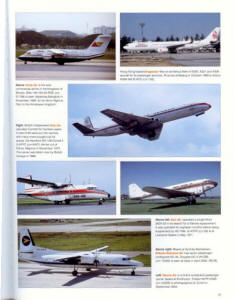|
Midland Publishing Company |
|
1000 Civil Aircraft in Colour |
|
by Gerry Manning |
|
Reviewed By Brian R. Baker, #43146 |
|
|
|
MSRP: $34.95 USD Most of us who have been involved in aircraft photography for any length of time (I have been active since about 1951) allow our photo collections to languish in file cabinets or storage boxes, and relatively few people ever get to actually see the slides or photographs unless someone badgers us for a print or duplicate for some project or other, or we attend one of those rare “slide fests” where each collector is allocated a short time period to show his best stuff to other critical collectors. Gerry Manning is breaking this tradition by publishing a book loaded with excellent color photos of civilian aircraft in a fascinating variety of color schemes and markings. More of this type of book needs to be published. As we all know, aircraft have a tendency to disappear over a period of time, and airlines go out of business or are merged with their more successful competitors. Some aircraft are used for only a brief period of time before they are discarded or scrapped. Thus, the preservation of photos of these aircraft becomes vital for the aviation historian, if a record of these aircraft is to be preserved for posterity. Fortunately, there are a few of us who have done this over the years, and it is the private photo collectors, not government agencies, who provide most of the photos we see published of older aircraft. The hobby, or should I say obsession, of aircraft photography actually began in the late twenties, when a few enthusiasts got together and standardized their hobby, using old folding 116/616 cameras to photograph aircraft to some pretty high standards. Through the thirties, the hobby expanded, and an organization, the International Aircraft Photographers’ Exchange, was formed. Members exchanged 616 negatives of aircraft, thus allowing collectors to have photos of aircraft they normally did not have access to. Just before World War II, color film was made available to the public, and although the majority of the “616 boys” kept shooting black and white, a few priceless photos were made of World War II aircraft on Kodachrome slides, mainly taken by pilots and ground crews who were serving in the Army Air Force or Navy. Following the war, the hobby expanded, although access to military aircraft was difficult because of security restrictions. Civilian aircraft were another matter, however, and in the early days, I recall walking up and down the active airline ramps at various airports, shooting pictures indiscriminately as long as I didn’t get in the way. That’s a far cry from post-911 airport security, where military aircraft are sometimes easier to photograph than civil types. With the demise of 616 film about 1976, most photographers switched to color slides, which are traded regularly and which provide much better historical information than black and white photos. Today, 35 mm slides are standard, although digital photography is making inroads as slide film becomes less available and the quality of digital equipment improves. Telephoto lenses have also widened the scope of aircraft photography, where with the right equipment; a photographer can get great photos of aircraft from vantage points far away from secured areas. Gerry Manning is obviously one of the British photographers who has ramp access and who has the opportunity to travel worldwide in search of unusual airplanes. This seems to be the trend in Britain, where a young man will plan his career around his hobby, and work in some area of the aviation industry, usually the airlines, where worldwide travel is a perk used to gain access to airport flight lines and ramps. The majority of the work in this book belongs to Manning, although several other photographers are credited, including Bob O’Brien, John Smith, and Steve Williams. All of the photos are in color, and are of the highest quality. They are not posed, stilted shots of airplanes “in the clear”, but they depict the airplane in its operating environment, whether is be on the ramp, the taxiway, runway, or in the air. A few are shown after retirement, but most are active. This is a book primarily about civil airliners, understandably mainly European, but also included are a few charter types and some fire bombers and helicopters active in the USA and Canada. The key point here is variety, especially in some of the promotional color schemes that airlines have used in the past thirty years. Most of the photos are less than 10 years old, although some of the photos date back to the seventies. Anyone interested in the amazing variety of airliners and color schemes that have been used over the years should buy this book. I guarantee you that you will spend many hours going through it, learning something new each time. Another feature of the book is that each photo has an explanation, telling exactly what the airplane is, its registration, factory serial number, the owner-operator, and where and when the photo was taken. In addition, sometimes very interesting facts are presented about the operators or the airline, telling when they operated or went out of business, and other facts that the reader might be interested in. Serious photographers record this information, or at least look it up after they get home, and it makes the photos more historically significant. Recommendation: If you are interested in modern civilian aircraft, this is the book for you. The photos are fascinating, and of high quality, and the color is outstanding. Thanks to the publishers for the review copy. To order this book call 1-800-895-4585 or on line at www.specialtypress.com. |
|
Information, images, and all
other items placed electronically on this site |

